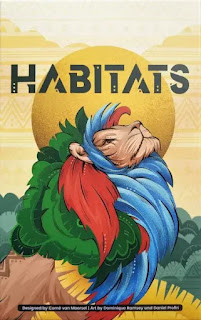I'm not overly interested in computer or video games, but every once in a while one comes along that catches my interest. In the early 2000s I was quite fond of Zoo Tycoon, a zoo-building game that covered everything from building well-balanced enclosures to managing crowds and balancing income and expenses. My favorite part of the game was building enclosures for the animals; you had to balance different kinds of terrain, topography, and just the right type and amount of trees and bushes to keep the animals happy.
A Zoo Tycoon board game came out last year, but I found it to be a little too fiddly and complicated to be enjoyable. I started looking around for another game that would scratch the same itch. Ark Nova is a great zoo game and includes some of the building element that I enjoyed in the Zoo Tycoon computer game, as do Dinosaur Island and DinoGenics, although they are more focused on cloning dinosaurs and stopping them from eating your park visitors.
I recently stumbled across Habitats, a game from a small publisher based in the Netherlands that has since been reprinted in the United States. And I must say, it is exactly the game I wanted.
In Habitats, you're managing a nature preserve rather than a zoo, so the thematic goal is entirely to create an environment that your animals will be . It's a tile-laying game with one really interesting innovation: the way each player picks up new tiles to play. The game starts with a grid of tiles in the center. Each player has a jeep meeple ("jeeple" just seems too precious) that moves around the grid, one tile at a time. On your turn, you can choose a tile that is ahead or to the left or right of your jeep. After choosing a tile you move your jeep into the tile's space, and then place a new tile in happy withthe space you just vacated. It means that you have a choice of three tiles to pick from each turn, but it also adds a lot of interesting strategic decision-making to the game. There might be a tile you really want that you need to move through a few less desirable tiles to get to, or you might be racing to a particular tile in order to get there ahead of your opponent.
Most of the tiles represent both an animal in search of a suitable habitat, and a type of terrain that adjacent animals might want. Tiles are played in a grid pattern in each player's tableaux. An animal tile will indicate one or more types of terrain, either water, desert, grassland, or forest, that need to be on adjacent tiles in order for that animal to be happy and score points at the end of the game. Other tiles represent watchtowers that score based on the tiles in various patterns around them; tourists that score depending on how your different terrain is grouped; and gates and campsites that earn points depending on how many tiles they are adjacent to.
The game becomes a puzzle-like exercise where you want to place your tiles so that adjacent animals can make use of each other's terrain as much as possible, and multiple animals can benefit from the same groupings of terrain. In addition to scoring your tiles at the end, the game is split up into three "years" composed of a number of turns (depending on the number of players), with two goals for each year that will award additional points to whoever fulfills them most completely. They are things like the most sets of different types of terrain or the longest unbroken line of tiles, and they give you something else to work for as you decide how to place your tiles.
An optional extra, available from the publisher's website, is a set of animal meeples that can be used to indicate when an animal tile has reached the conditions it needs to score points. They are entirely unnecessary (the base game comes with simple tokens for this purpose) but add to the tactile quality of the game and make it look that much more impressive on the table.
It's not a terribly complex game (the rules for the U. S. edition published by Allplay clock in at 4 pages), but it is very engrossing, giving you a lot to think about as you play but also requiring you to think on your feet and not get too attached to any one strategy or tactic. It's not quite Zoo Tycoon, but it definitely fills the same void, and in many ways it's more enjoyable.Rating: 5 (out of 5) The highest praise I can give a game is that as soon as I'm done playing I want to play again, and that is definitely true with this one.


